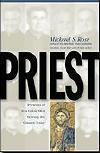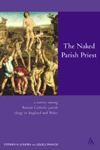Issue Date: November 7, 2003
Reviewed by WAYNE A. HOLST Two differing perspectives on the modern Roman Catholic priesthood are reflected in books recently published in the United States and the British Isles. The first is an unapologetic celebration of priests; the second, a candid and sometimes unsettling indication of matters currently affecting the priestly heart. Priest by Michael S. Rose is written to counter media reports insinuating a general moral stain on the priesthood emanating from the current sex scandals. Rose presents the stories of 10 good American priests (prototypical of the majority, he believes) whose virtues of courage, humility, sacrifice and charity reflect a thriving though numerically reduced body of faithful servants. These men remain worthy of the support and gratitude of the people with whom they minister. Rose accurately notes that seldom is this side of the priesthood portrayed in the media, nor is it commonly understood and appreciated. The Naked Parish Priest is an example of empirical theology, or the scientific study of religion, conducted by two English clergy-psychologists. Msgr. Stephen Louden, a Roman Catholic, is a former vicar general in the British Army. Leslie J. Francis is an Anglican professor of theology at the University of Wales, Bangor. Their purpose in preparing an extensive questionnaire and analyzing almost 1,500 responses was to determine what English and Welsh priests really think about their profession and its modern challenges. Rose has written prolifically on subjects that challenge modern liberal American Catholicism. Most recently, his Goodbye, Good Men (Regnery, 2002) blames the priestly vocations shortage and much of the sex scandal on authorities who have discriminated against candidates affirming classic Catholic moral teaching. He believes the priesthood has been hijacked by leaders with profound spiritual problems. The problem, he says, is more often than not a failure of young men to hear and faithfully answer their calling; a failure of seminaries and bishops to form and educate their future priests properly; a failure of the ordained to focus on the duties of their state in life; and a failure of the laity to offer the proper spiritual and moral support for their pastoral leaders. This book advocates a revisiting and renewing of the classic gender-specific Catholic clerical forms and functions. Rose says nothing about the ministry of the laity or of expanded roles for women, except that they serve as supporters of male clergy. To his credit, Rose celebrates what is good about what is becoming, proportionately, an ever-smaller cadre of male priests. To his discredit, he believes that the future of the priesthood is as much about attracting the “right men” as it is about weeding out those who don’t belong. This leaves the author’s prescription less satisfying, liberating or visionary than it might be. Louden and Francis report on priestly perspectives from their Catholic Parochial Clergy Survey using 1996 British census tracks, but they do not attempt to interpret the results. They see their work as groundbreaking, establishing terms of reference for more extensive future research. The book contains 22 tightly focused chapters covering such priestly concerns as training for ministry, celibacy, core doctrines, ethical stance on current issues, fallen priests and clergy burnout. Attention was paid to the views of priests trained before Vatican II; those who were spiritually formed in the wake of the council and those who have entered ministry in the last two decades. The church seems to love secrecy, the authors discovered. Their study had to be conducted without the blessing and cooperation of the English Catholic bishops. This led the researchers to conclude that there is an ingrained official culture within the Catholic church that is anxious to preserve the church’s image at all costs. The church leadership demonstrated, by its reaction during the preparation and distribution of questionnaires and after the results were made public, that it is inclined to be hostile to academic endeavor and debate on sensitive matters like many of those considered in the survey. While some of the just over 40 percent who responded reflected a priestly culture of dependency (one candidate hoped that the authors would be “allowed” to publish their results), the majority of those returning surveys spoke candidly and authentically. Personal comments, in addition to specific responses to questions asked, were often more revealing than the formal replies themselves. A final chapter distills and highlights the main findings. The core views of priests, shorn of any professional distance, are offered with honesty and conviction. Generally speaking their doctrinal opinions tend to follow official church teaching while the moral views they hold question authority. The overall findings present a positive view of the church at the beginning of a new millennium. During these challenging times for the church, the voice of the priesthood seems often to be muted. Both books bear witness to a priesthood that, even when it speaks under duress and in the process of change, remains faithful and open to the future. Wayne A. Holstis a parish educator teaching religion and culture at the University of Calgary in Canada. National Catholic Reporter, November 7, 2003 |

